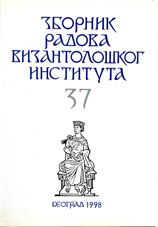"Насељени градови" Константина Порфирогенита и најстарија територијална организација
"Inhabited Cities" of Constantine Porphyrogenitos аnd the Oldest Territorial Оrgаnizаtiоn
Author(s): Sima M. ĆirkovićSubject(s): History
Published by: Vizantološki institut SANU
Summary/Abstract: In his work De administrando imperio, in the chapters on the South Slavs (ch 2936) Constantine Porphyrogenitos made a difference between actual 'inhabited cities' (kadtra oikoymena) and 'deserted cities' (eremokadtra) from Roman times, laid waste by the Avars and the Slavs. Each chapter is followed by a list of these 'inhabited cities', which were the subject of close scrutiny of the commentators of the Emperor's work and the researchers of SouthSlavonic history. A survey of older literature on them was outlined by B. Ferjančić in Vizantijski izvori za istoriju naroda Jugoslavije II Beograd 1959. Starting from the previous results and the assumption that these 'inhabited cities' must have represented the skeleton of territorial organization, the author examines the relation of each individual 'inhabited city' towards the environment, its position in relation to antique settlements and communication arteries, and compares all these with the network of settlements and the territorial organization of later epochs (12lh15th centuries). The second part is devoted to 'inhabited cities' in three principalities on the coast (Pagania, Zachlumi and Terbouniotes), but only the ones that have been identified with great certainty. The third section focuses on other cities in the aforementioned principalities and in Dioclea, while the fourth deals with cities on the considerably broader territory of the 'baptized Serbia'. The closing paragraphs contain a comparison of the littoral region with the 'baptized Serbia'. Several differences have been established: in the number of cities in relation to the total surface of the region ('inhabited towns' are more rare in the provinces), then a difference in relation to the surrounding territory (in coastal regions, the name of a city is identical with the name of the surrounding territory in 50 per cent) and different productivity tenth-century cities in the provinces ar not continued.
Journal: Зборник радова Византолошког института
- Issue Year: 1998
- Issue No: 37
- Page Range: 9-32
- Page Count: 24
- Language: Serbian

